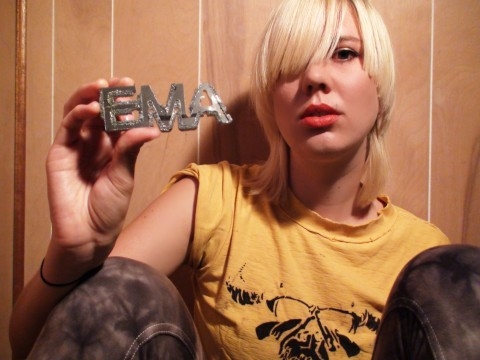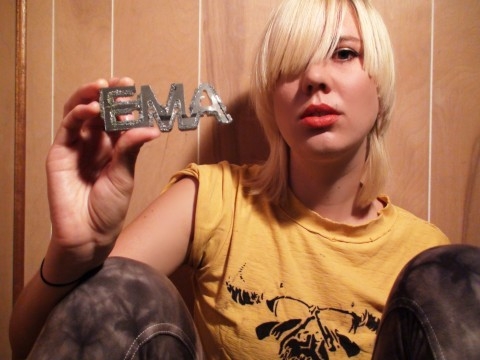EMA @ Kilby Court 06.24 with Strong Words, Secret Abilities
Show Reviews

Listening to EMA’s latest release The Future’s Void created a very specific sonic landscape in my temporal lobe. Each slash of the guitar built towers of broken computer monitors flashing with disparate, low-fi images, and each of Erika M. Anderson’s haunted wails created a catastrophe of shattering, fluorescent light bulbs. That being said, I was curious as to how tonight’s performance would capture the crackling phosphorescence that explodes out of the album.
Before the headliner, Utah locals Secret Abilities and Strong Words were there to warm the crowd up. Secret Abilities brought a pretty cool retro-rockabilly vibe along with them, and Strong Words offered some Sonic Youth-inspired shoegaze rock that was a nice transition between the bouncy, riff-heavy Abilities and EMA.
After EMA’s four-piece troupe transformed the stage into something that resembled the musty basement lair of a computer hacker, I was surprised to see that the saturating noise-rock that they are known for was created with very few components. Anderson, taking the stage in radioactive-green hot pants, Doc Martens and a baggy Mickey Mouse tank top, evoked the trampled nostalgia of a ’90s pop star that has let the harsh world of celebrity take her for everything that she had. They kicked off their set with “Satellites,” a sonic onslaught in which homemade LED planks punched pixelated holes in the cloud of manufactured fog that swept over the band and audience. It was less an opening song than it was a full-blown performance piece, depicting that broken pop star’s gradual immersion into the infinite circuitry of a Gibson-esque cyberspace.
When the band shifted into the material from 2011’s Past Life Martyred Saints, it was almost like a flashback to that pop star’s plummet into the dissociative world of product placement and photoshop. On “Butterfly Knife,” Anderson’s visceral guitar solo registered like the fists of a brawler that wants nothing more than to make sure your nose never looks the same again. With “California,” Anderson leapt upon the amps that typically shield the audience from any contact with the performer and got right in the crowd’s faces as she belted out her “fuck you” anthem to the shards of broken dreams that we can’t help but walk over barefoot.
Though EMA’s musical style tends to be bruising and isolated, there were moments of deep sincerity and retrospection that generated some emotional connectivity during the show. On the subdued “3Jane,” Anderson slid to the ground like a teenager who has just come to the realization that childhood is really over. Anderson’s textured voice sailed across the crowd as she enunciated the pain that comes from living in a viral world where privacy and individualism are slowly turning into page views and status updates.
In contrast to songs that create massive sonic ebbs and flows, a song like “Marked” might feel out of place, since the majority of the song is nothing but Anderson and her guitar. But with each raspy whisper of “I wish that every time he touched me left a mark,” it becomes clear that the sonic restraint was deliberate—it can make the sheer force of a well-placed lyric strike like a coiled rattlesnake.
EMA’S performance varied widely from that of the majority of musicians that I have seen. Musically, the band was spot on, and covered some considerable range with four or five well-played instruments. Serious praise is due for Leif Shackleton, who constructed most of their stage design and instrument racks himself. He’s also responsible for bringing the frayed electric sound from album to stage—the majority of which is created by his prodigious skill with an electric violin. Despite the fact that Anderson was friendly and approachable while running their post-show merch booth, her stage presence is fantastic—and kind of terrifying. Through her live performance, she was able to capture the versatility of her music, resulting in an emotional punch to the gut that was both sincere and thought-provoking. The LED towers that stood like neon monoliths on either side of the stage added a level of visual interest that so few bands seem to care about—it really made the show feel like less of a band coming to play their stuff and more like a marriage between musical and visual art.

